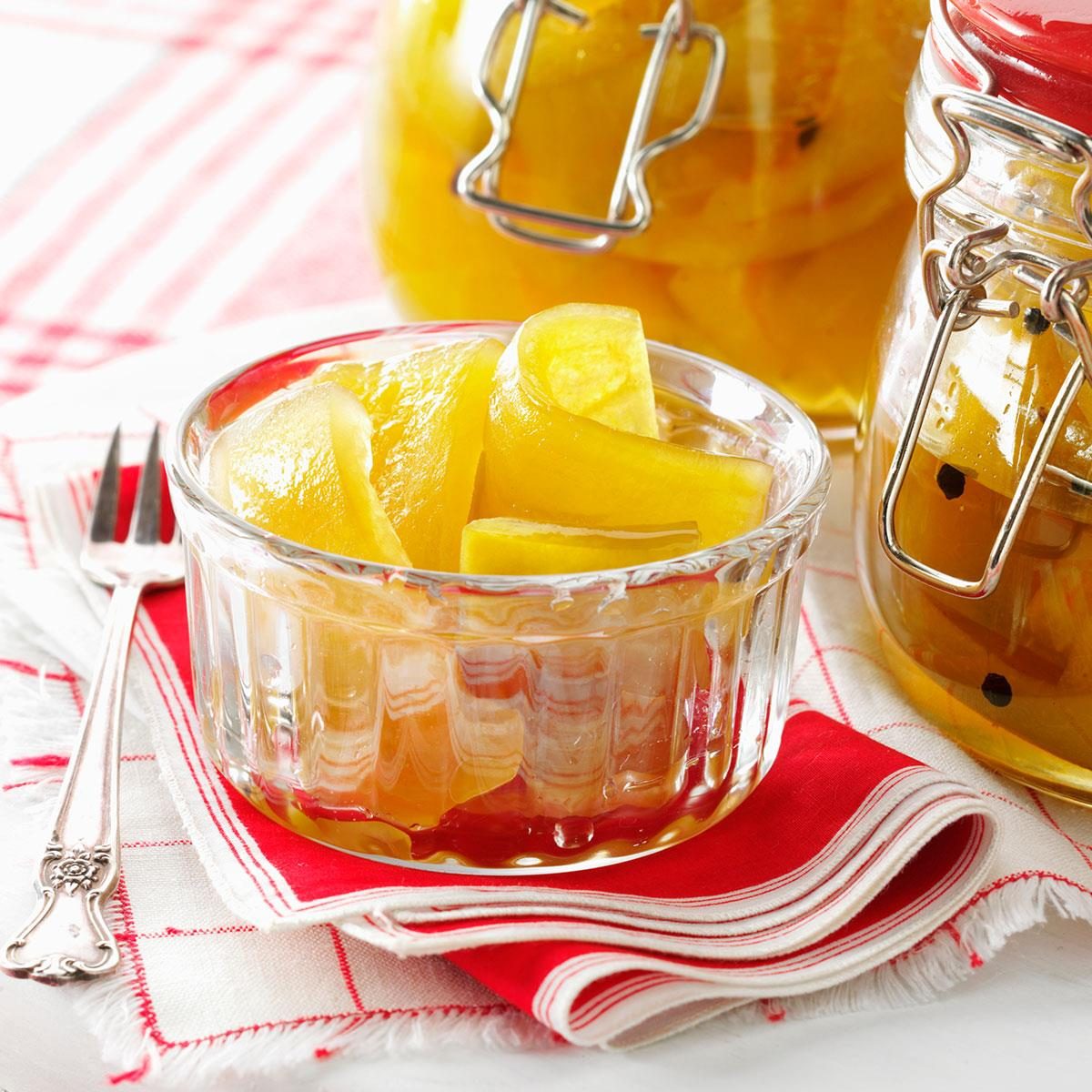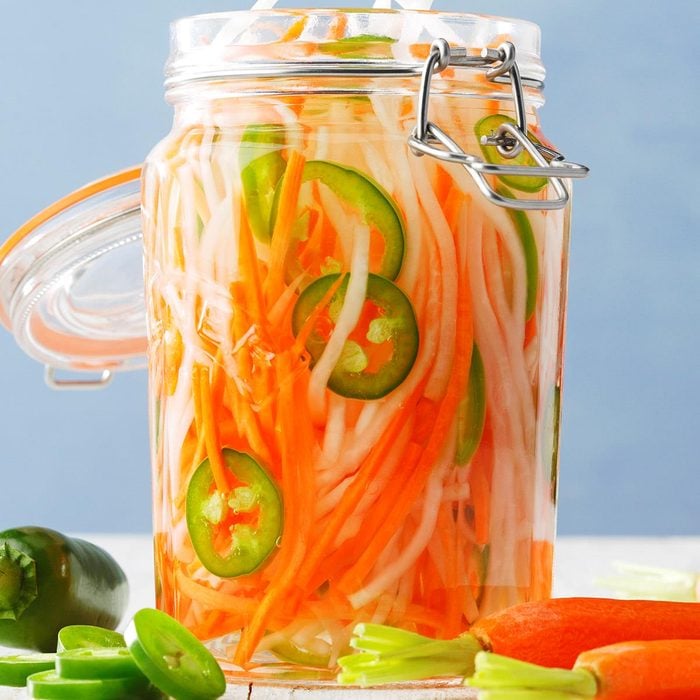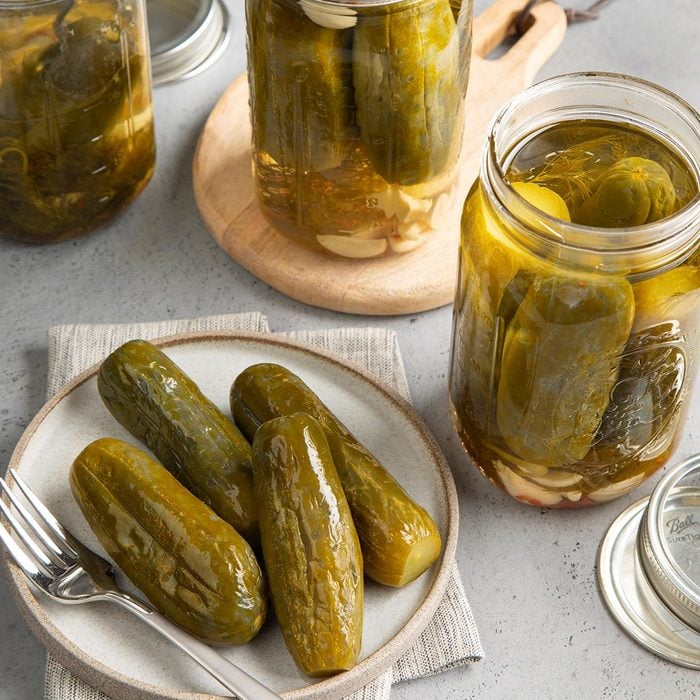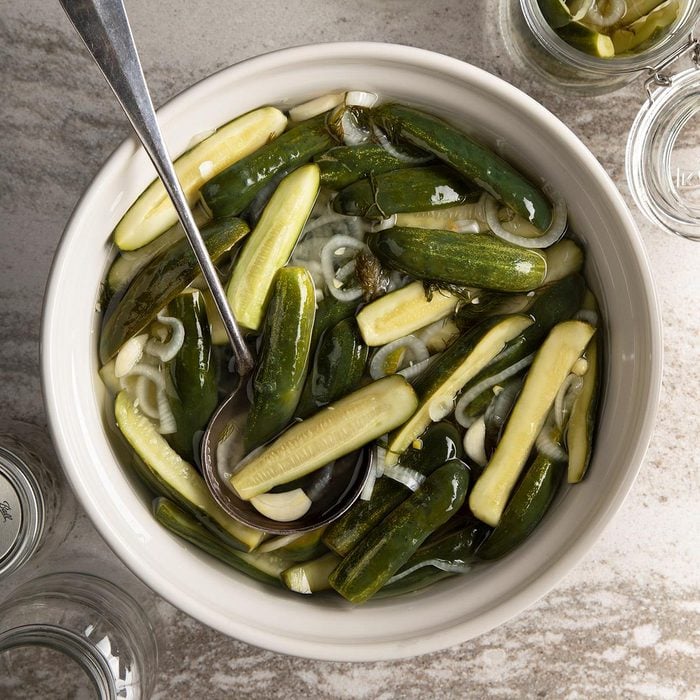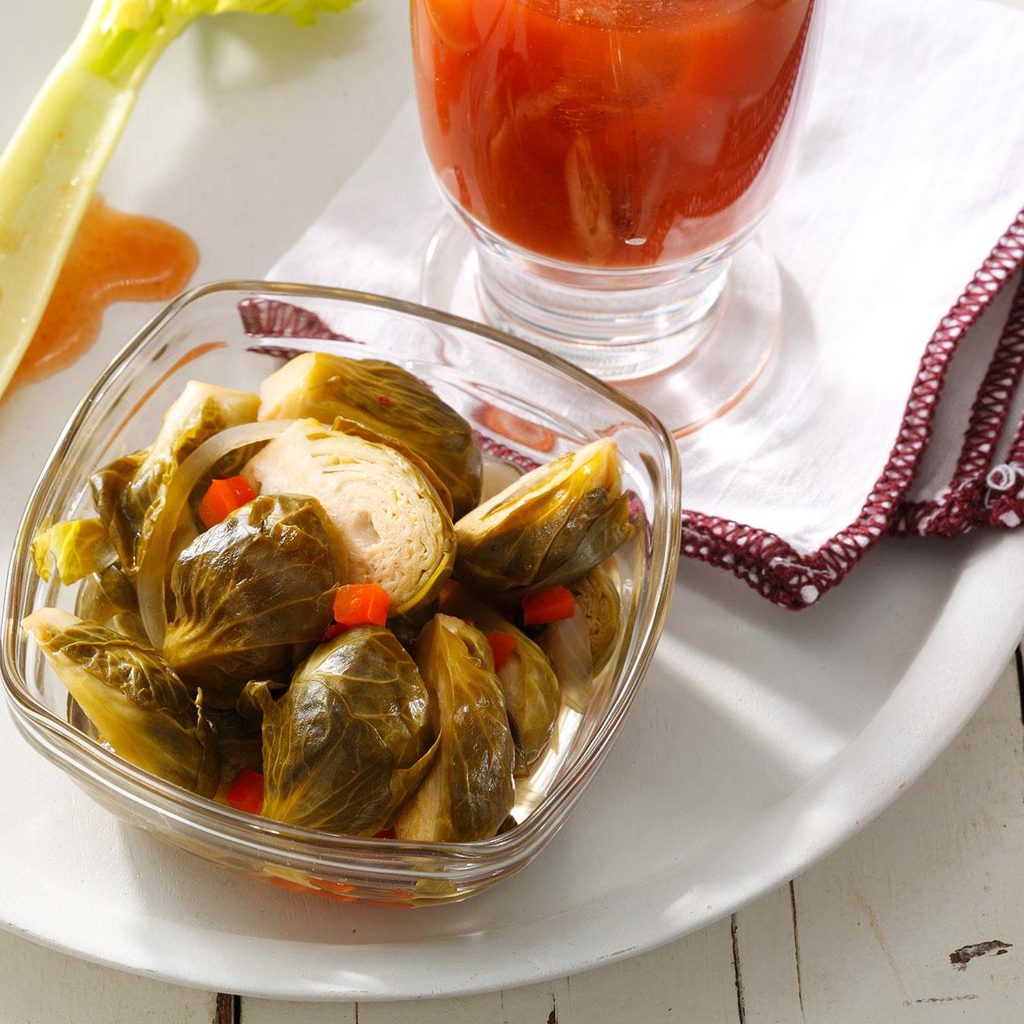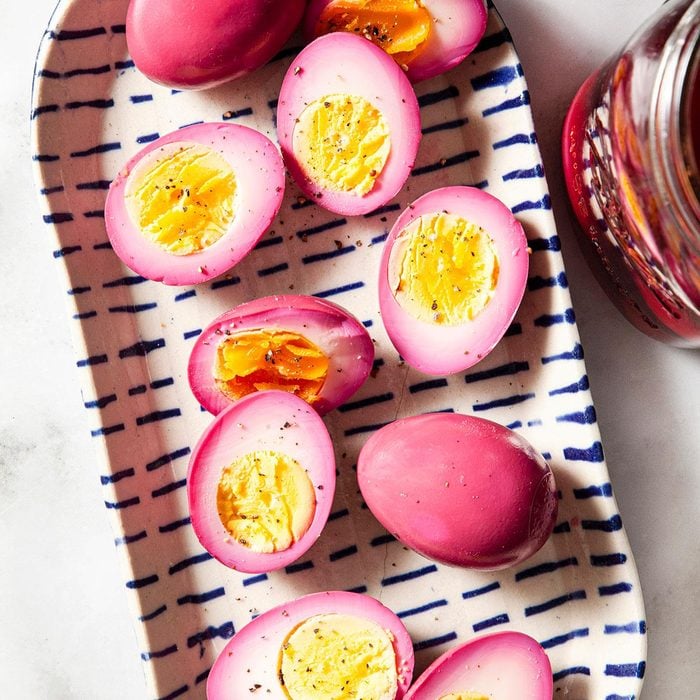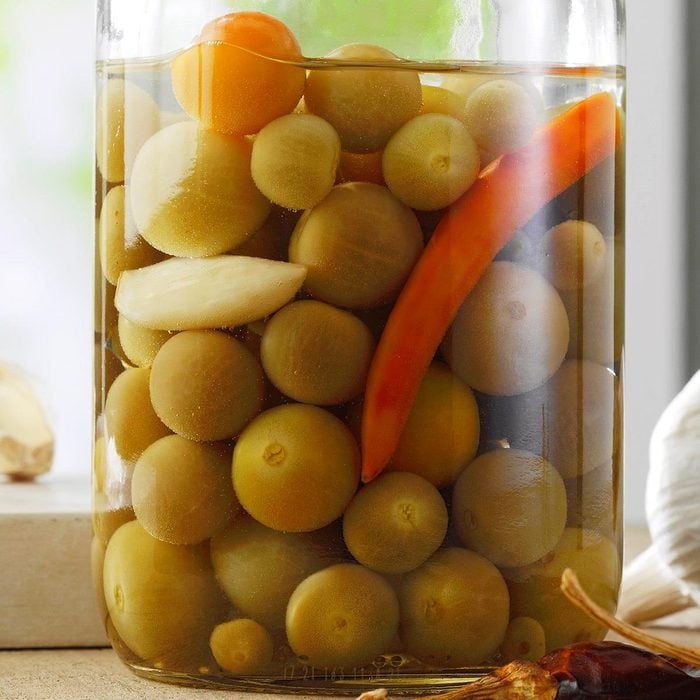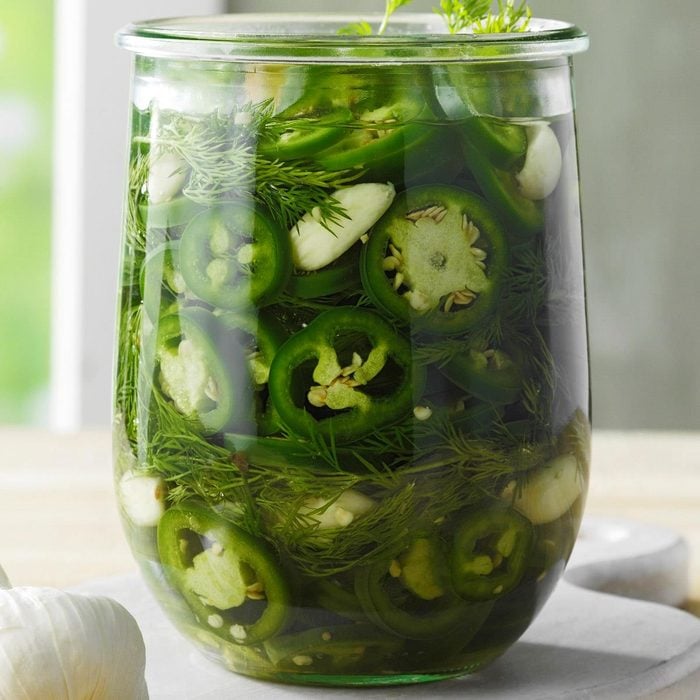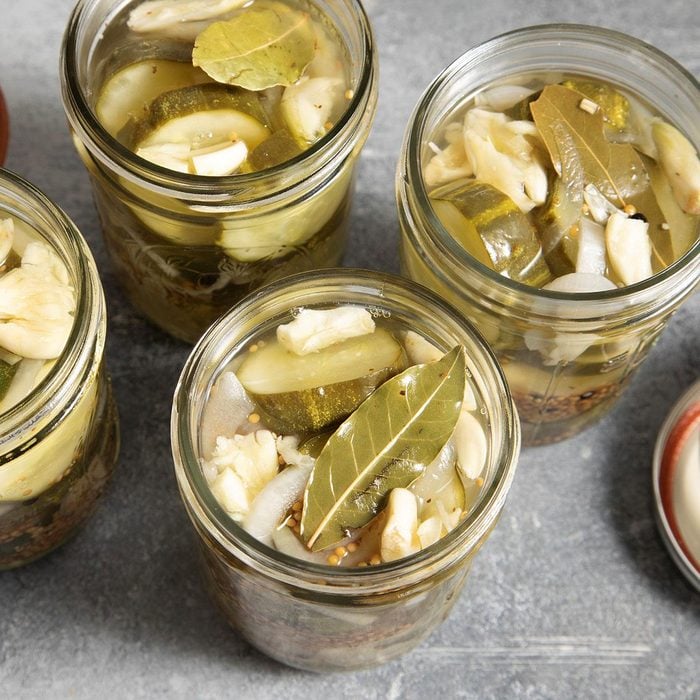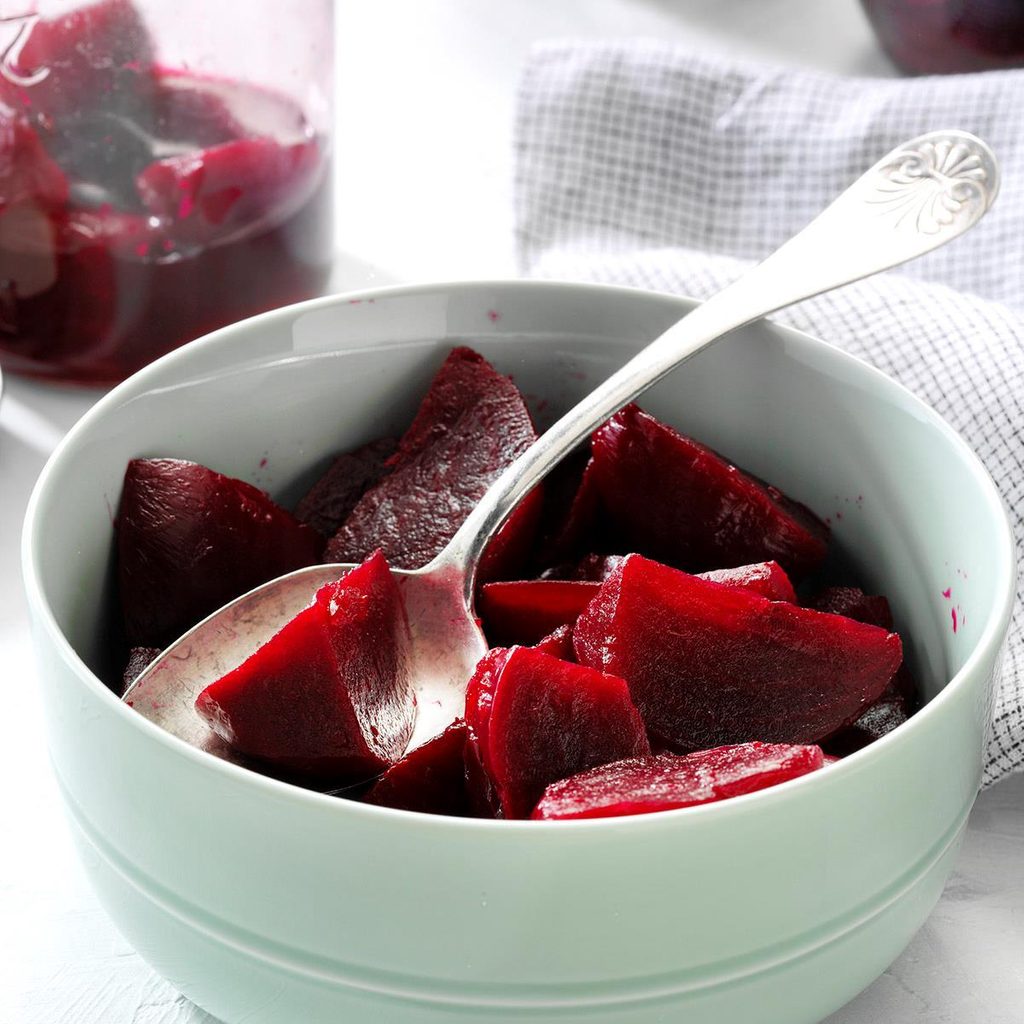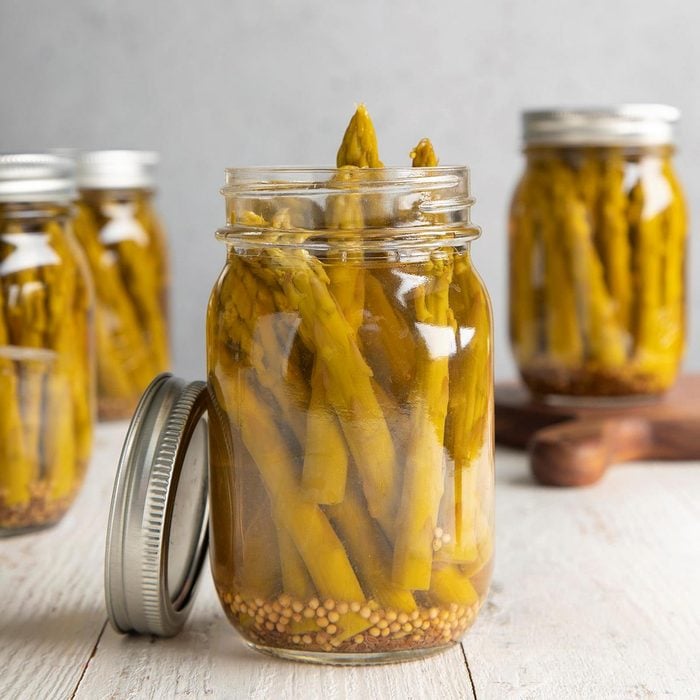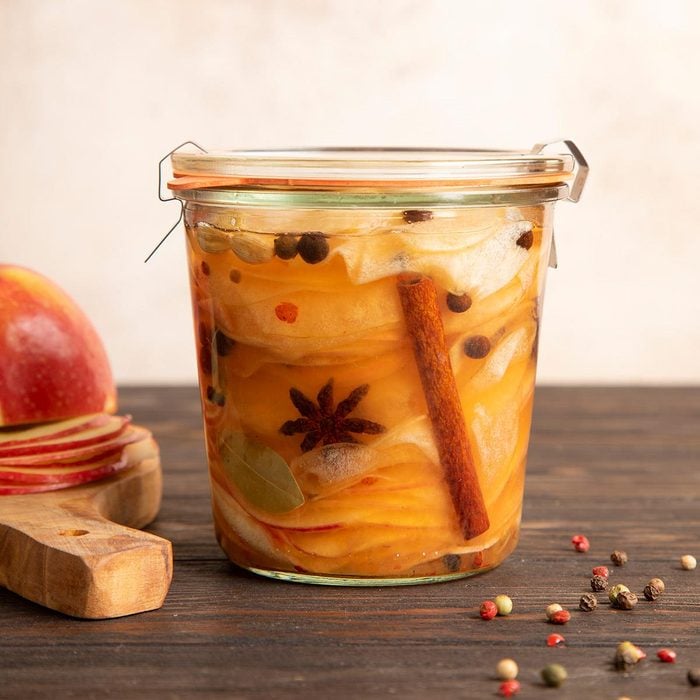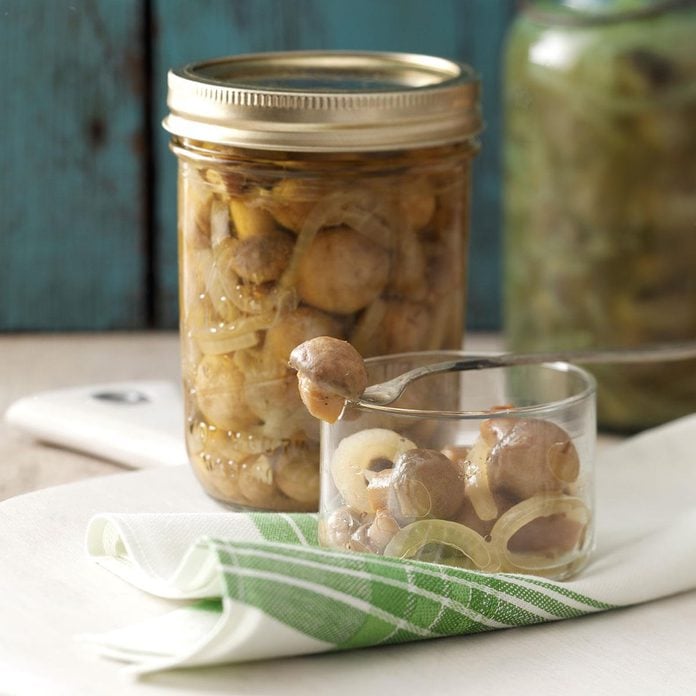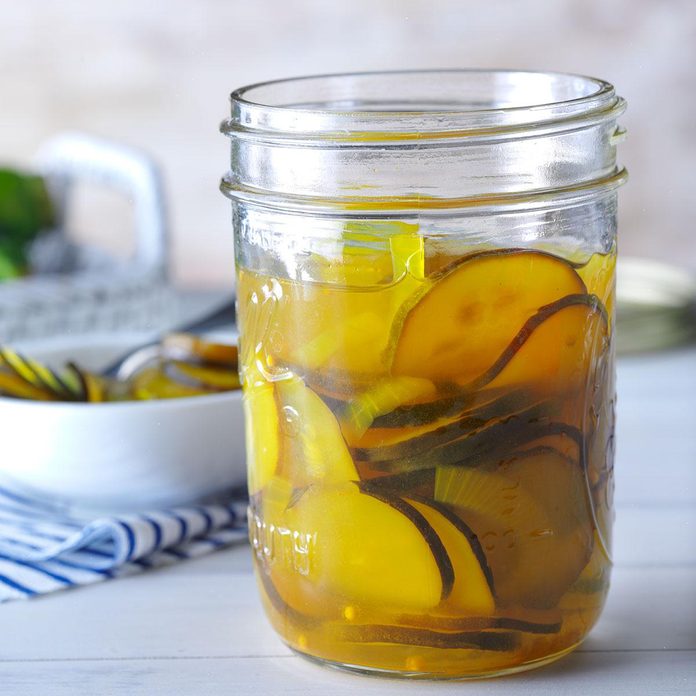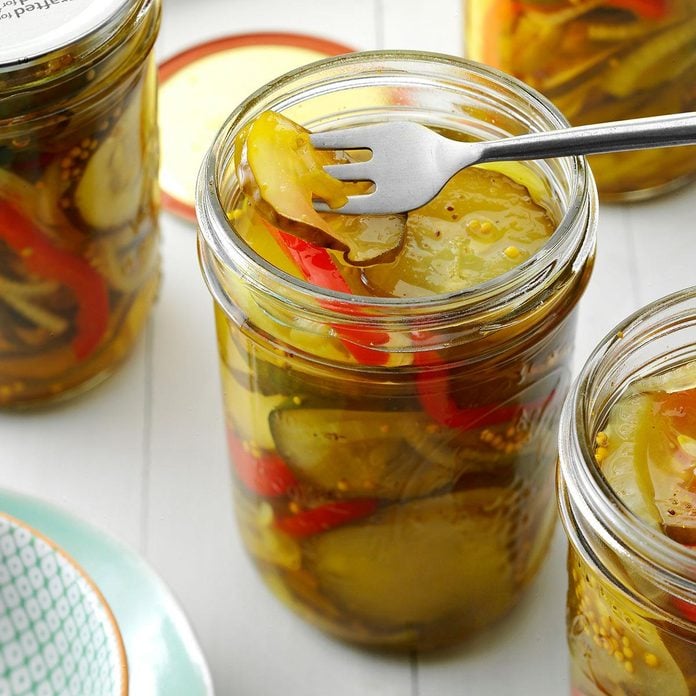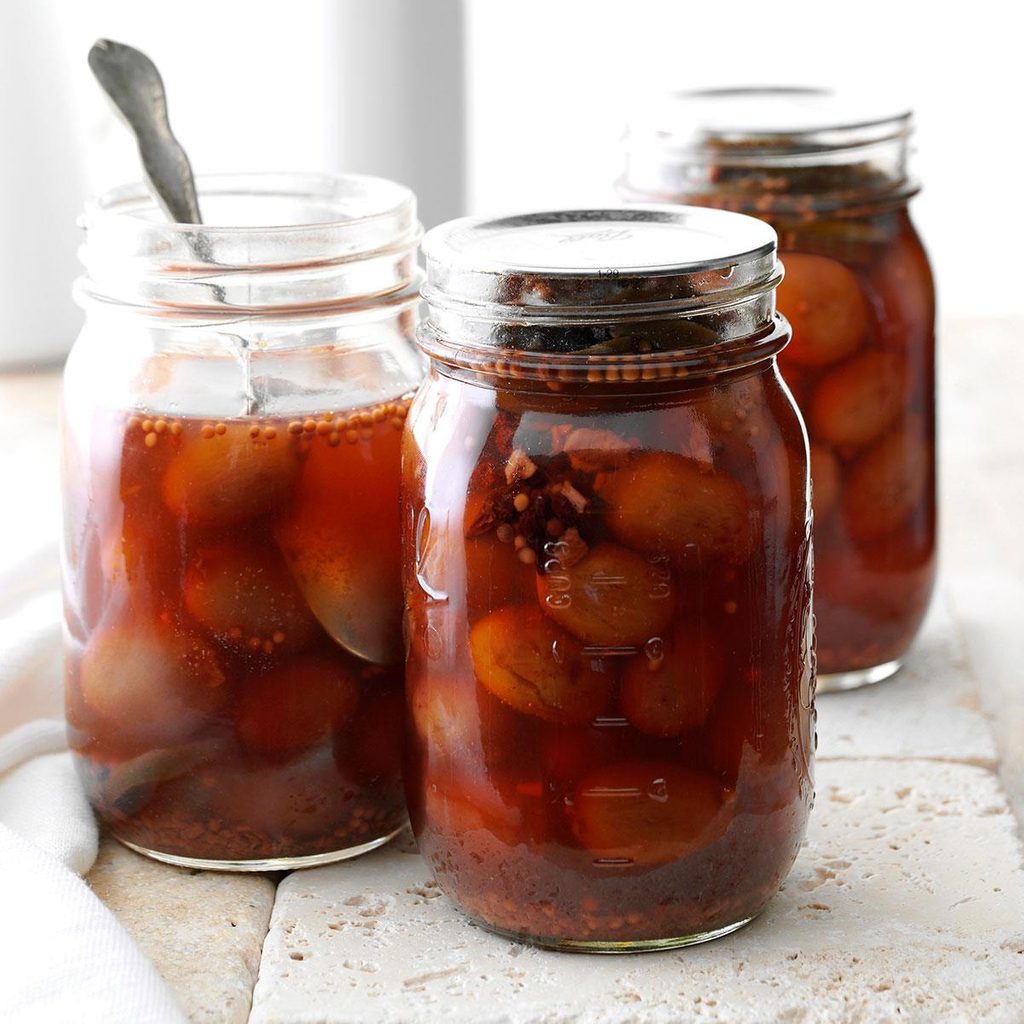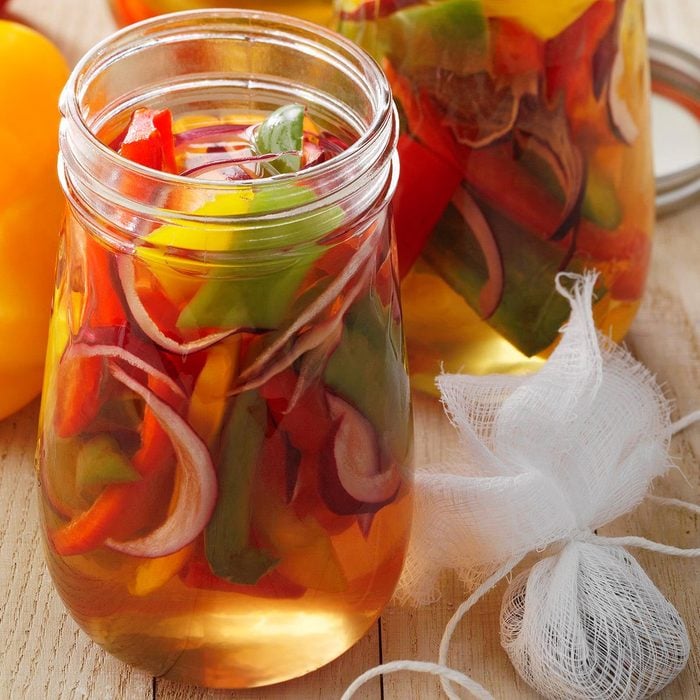Pickles are one of those foods that inspire strong opinions. You’re either a pickle lover—willing to pick up a bag of pickle snacks and take a pickleback after a shot of whiskey—or you avoid these crispy, tangy snacks at all costs. Personally, I’m not willing to delve too much into the litany of pickle-flavored foods, but I can’t get enough of pickles themselves.
There’s nothing better than a sweet-and-tangy bread and butter pickle on a burger, using watermelon rind pickles to brighten up a salad, eating pickled okra straight out of the jar as a snack, or (literally) getting intoxicated with the moonshine pickle.
As a former restaurant chef, I’ve made a ton of pickles in my life. And there are so many easy pickle recipes you can make at home (especially if you’re not canning them to make them shelf-stable). But what are pickles, and what’s the difference between the ones you make at home and the jars you find at the grocery store?
What are pickles?
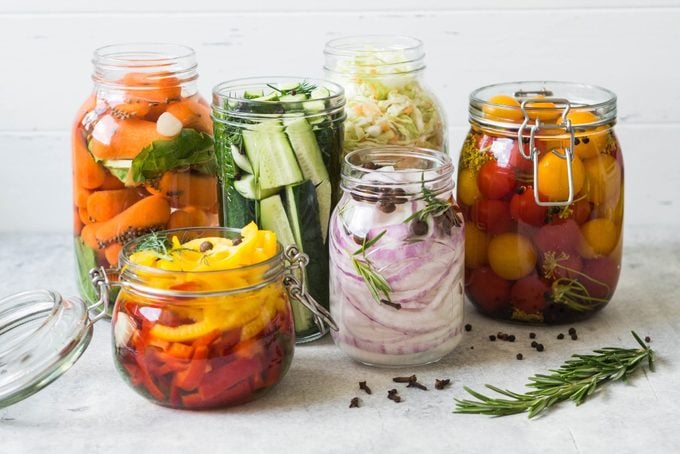 Olga Peshkova/Getty Images
Olga Peshkova/Getty Images
The Merriam-Webster dictionary defines a pickle as “an article of food that has been preserved in brine or in vinegar.” It goes on to say, “specifically: a cucumber that has been so preserved,” but that doesn’t mean that pickles are always cucumbers.
The word pickle likely comes from pekel, the Dutch word for brine; pickles were historically made by submerging vegetables in salt-water brine. This process creates lactic acid, creating an environment that’s too acidic for bacteria to grow.
Today, we refer to these pickles as lacto-fermented vegetables, but many pickles are made with salt and vinegar brine instead. The vinegar reduces the pickle’s sour, fermented flavor while increasing its acidic presence.
There are several different types of pickles—like gherkin, bread and butter, and sour pickles—and they differ depending on the ingredients that make up the brine. Popular pickled vegetables (other than cucumbers) include peppers, cauliflower, onions, carrots, beets, mushrooms and green beans.
Don’t discount fruit when preparing pickles, either. Fruit pickles can be made with any type of fruit, but our favorites are pickled grapes, melon, cherries and berries (like these spicy pickled strawberries). The brine brings out the fruit’s natural sweetness, while also preserving them for snacking all year round. For a fun spin on a traditional pickle, try making pickled watermelon rinds.
Also check: What’s sweet, sour, spicy, and red all over? A chamoy pickle, the latest viral recipe taking over TikTok.
Where do pickles come from?
 istetiana/Getty Images
istetiana/Getty Images
Historically, pickling was used as a method of preservation. According to PBS, pickles date as far back as the Tigris Valley in 2030 BCE. Pickling was a way to preserve fruits and vegetables for sustenance during the cold winter months, and pickles were easier to pack for traveling than fresh produce.
Kosher dill pickles became popular in the United States in the early 1900s, when an influx of European Jews brought their culture and cuisine to New York City. These flavorful full sours and half sours (fermented for half the time) brought a bright contrast to bland meat-and-potato diets and were sold straight out of the barrel.
In modern times, pickling at home has never been easier. Mason jars with specially created lids seal pickles inside a jar of brine. While safety precautions must be strictly followed to prevent contamination, it’s simple to make your favorite pickles in the comfort of your own kitchen. National Pickle Day (November 14) is a perfect day to celebrate by learning how to can pickles.
Are pickles good for you?
Pickles are a vegetable, but are pickles good for you? Yep, they are. Pickles are rich in vitamins while being low in calories, making them a great snack food. Lacto-fermented pickles (like traditional kosher dills, sauerkraut or kimchi) may have additional health benefits—these types of pickles contain probiotics that can help support gut health.
How are pickles made?
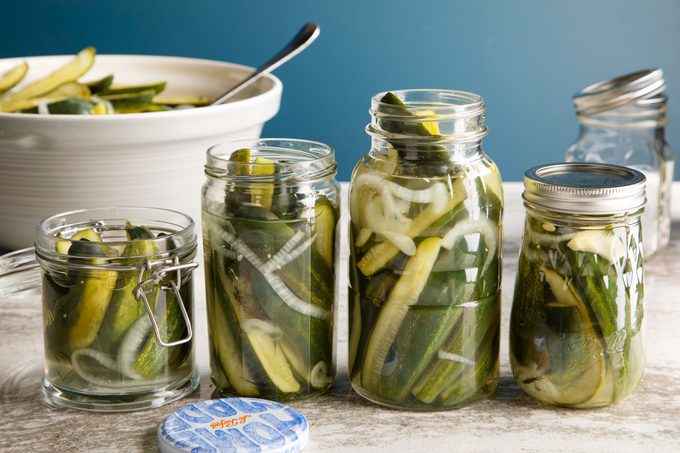 Taste Recipes
Taste Recipes
To make traditional salt-brined pickles, you’ll need about 2 pounds of cucumbers and a 1/2 gallon mason jar, or 2 quart jars. Unsure which cucumbers to buy or grow? Read up on the best cucumbers for pickling.
Wash each cucumber and remove about 1/2 inch from the flower end. Pickles are traditionally made with whole cucumbers, but you can cut them into slices or spears if you like.
Make a 3% brine by mixing 2 tablespoons salt with 5 cups cold water and stir until the salt dissolves. If you want to add more flavor, pack the bottom of the jar with sliced onion or garlic and spices, such as chili flakes, dill seed, mustard seed, fennel seed, coriander seed or peppercorns. Add a few bay leaves and a handful of fresh dill if you like the taste of dill pickles.
Pack the cucumbers into the jar, pressing everything down to ensure there is an inch of headspace. Pour the brine over the cucumbers and weigh them down with a weight until they’re submerged under the brine. If you don’t have a weight, fill a zip-top bag with more 3% saltwater brine and use it to keep the cucumbers down. Cover the jar loosely with a towel and place it in a cool, dry place.
After a few days, the liquid will start to bubble and become cloudy. The longer the pickles ferment, the more sour they become, and the texture fades from crisp to soft. Give your pickles a taste to check the flavor and texture before transferring them to the refrigerator. You should achieve “half-sour” status in about 3 to 7 days, and “full-sour” in 12 to 14 days.
Once you move the finished pickles to the refrigerator, they should last up to 7 months.
What are the different types of pickles?
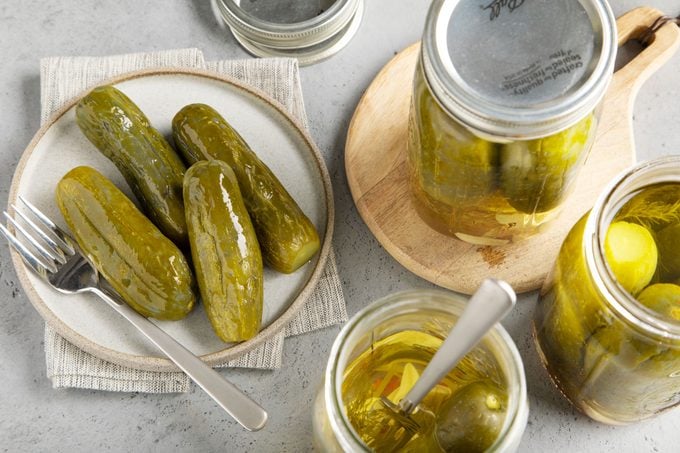 Taste Recipes
Taste Recipes
As we mentioned earlier, there are different types of pickles depending on the ingredients in the brine. Which are the best pickles? That depends on your tastes! If you’re a pickle lover, you should definitely know about (and try!) these types of pickles.
Dill Pickles
Dill pickles are the most popular type of pickle in the United States, and the grocery store is packed with them. You’ll find them whole, cut into spears or sliced into chips. These brined cucumbers are packed with dill seed or fresh dill to give them a punch of flavor, perfect for pairing on top of a burger or used in Dill Bloody Marys. They’re often enhanced with additional spices as well, including garlic, pickling spice or pepper flakes, like in these old-fashioned garlic dill pickles.
Bread & Butter Pickles
These pickles got their name because they’re so delicious that you can turn them into a sandwich with nothing more than pickles, bread and butter. They’re a type of sweet pickle made with a sugar and salt brine, creating a balance between sweet and sour. You’ll also find turmeric in the brine, giving the pickles their characteristic yellow tint. Most bread and butter pickles are also made with spices like mustard seed and celery seed.
Sweet Pickles
Sweet pickles have added sugar in the brine, giving them a candy-like finish. Most sweet pickles also contain onion and spices, and they may call for extra vinegar to balance out the sweetness. Add them to a potato salad for a sweet version that many will love.
Cornichons or Gherkins
Cornichons are made with gherkin cucumbers, a small variety that’s bumpier than most cucumbers. These tiny cukes are picked while they’re extremely small, creating 2-inch pickles that are perfect for serving whole on a charcuterie board. They’re often vinegar-forward and bright, making them a good counterpart to bold French cheeses.
Sour Pickles
Sour pickles are made in a salt-water brine, so they don’t have any vinegar flavor. Instead, the acidic (sour) flavor comes from the fermentation process. The longer they ferment, the tangier they are, but they won’t have the same acidic bite as a vinegar-brined pickle. Sometimes, they’re sold as half-sour; that means they didn’t ferment quite as long.
Kosher Pickles
Kosher pickles refer to the style of pickling brought to the United States by Jewish immigrants in the early 1900s. These pickles are made using a salt brine (just like sour pickles), and they contain generous amounts of garlic and dill. If you enjoyed this, then learn how to make pickle de gallo.
Quick Pickles
Quick pickles (sometimes referred to as refrigerator pickles) are homemade pickles soaked in vinegar and spices. The ratio of salt to water isn’t important with these pickles, since they’re not designed to be shelf-stable.
They need to be consumed within a few weeks, but this method is a great way to introduce extra flavor and a bright acidity into vegetables for salads, sandwiches and more. Get started on this easy method by trying out this pickled beets recipe.
Do pickles expire?
Pickles are very hearty, but they do have an expiration date. Homemade fermented pickles last 3 to 7 months in the refrigerator. An unopened store-bought jar of pickles will last up to 2 years past its expiration date, and about one year past the expiration date if opened and stored in the fridge.
You’ll know if pickles have gone bad if the lid starts to bulge, you observe any mold in the jar or on the lid, or if the contents of the jar smell off or feel slimy.
Our Best Pickled Recipes
Watermelon Rind Pickles
"Waste not, want not" has always been smart advice—especially when it produces pickled watermelon rind that's so refreshing. There are many
types of pickles and this for sure is one of a kind! Serve these straight out of the jar at your next backyard barbecue, and be prepared for all your guests to ask for this pickling recipe.
Go to Recipe
If you were wondering, you can also find out if pickles are good for you.
Pickled Carrots and DaikonThis recipe is inspired by a pickle my family and I enjoyed at a local Asian restaurant. It is a delicious side to roasted meats as well as a tasty condiment on a burger or sandwich. You won't miss the high fat dressing or mayonnaise. —Lisa Keys, Kennett Square, Pennsylvania
Garlic Dill Pickle RecipeIf you’re new to canning, learn how to preserve cucumbers with our garlic dill pickle recipe. Fresh dill, garlic and crushed red pepper flakes add a punch of flavor to regular pickles.
Is there a
type of pickle more iconic than garlic and dill? This recipe makes three 1-quart jars: eat one with these
homemade pastrami sandwiches, another with
Gouda turkey clubs and one all by itself with your bare hands. There's a reason this is one of our favorite pickling recipes!
Also check: What’s sweet, sour, spicy, and red all over? A
chamoy pickle, the latest viral recipe taking over TikTok.
Pickled StrawberriesI developed a unique healthy recipe to feature my most-loved spring and summer fruit. My favorite way to serve these pickled strawberries is as an appetizer with cheese. —Roxanne Chan, Albany, California
Refrigerator Dill PicklesEasy and economical, refrigerator dill pickles are tangy, zesty and crispy. No one will believe you made them yourself! —Jake Haen, Ocala, Florida
Pickled CornPickling doesn't have to be difficult, and it doesn't have to involve cucumbers either. Our pickled corn recipe is incredibly easy, and the result is a sweet and tart corn that tastes delicious on salads, nachos or tacos.
Pickled Brussels SproutsThis year, when I asked my brother what he wanted for his 31st birthday, he answered, "pickled Brussels sprouts." I had never even tasted a pickled Brussels sprout before. It's hard for me to say "no" to my younger brother, so he got his wish and thought the Brussels sprouts were delicious! —Heather King, Frostburg, Maryland
Brussels sprouts are delicious and versatile—they're good when
roasted,
grilled and even
raw. It should be no surprise that these sprouts are also outstanding when pickled with garlic, onion and a pinch of chili flakes.
Pickled EggsRed beets act as a natural dye for these pickled eggs and beets. They look gorgeous on salads and make the most vibrant deviled eggs for Easter appetizers or snacks.
Pickled Green TomatoesI had no clue what to do with all the green tomatoes from my garden until my husband said to pickle them. I thought he was nuts, but they are fantastic! Making pickled green tomatoes is a wonderful way to keep your garden produce from going to waste. —Lori Eaton, Downs, Kansas
Pickled JalapenosI started canning Hungarian hot and mild peppers with my dad every year, but they are hard to find in California, so I now make pickled jalapenos instead. They stay crunchy, unlike the mushy kind you find at the store. —Lou Kostura, Belmont, California
Homemade Pickling SpiceIf you’ve ever been overwhelmed by your spice rack, let this pickling spice recipe cut through the choices so you’ve got a go-to mix that’s perfectly balanced and versatile.
In the mood for pickling recipes, but don't have store-bought pickling spice on hand? There's a good chance that you already have the ingredients to make this homemade version. Then, get ready to make all kinds of
pickled vegetables.
Pickled CarrotsSweet, sour and salty all in one, pickled carrots are the perfect addition to a sandwich or salad. Here's how to make pickled carrots in just a few simple steps.
Best Ever Sweet PicklesOur classic tangy sweet pickles—canned in a water bath for easy storage—are a perfect garnish for sandwiches and burgers.
These pickle rounds are refreshing, crunchy and utterly irresistible. Chop the pickles up and stir into
old-fashioned egg salad, or use them as a sweet-and-sour accent on top of
spicy cheeseburgers.
Pickled Sweet PeppersPickled sweet peppers are a great way to give a quick boost of flavor and crunch to sandwiches, meat dishes, tacos and pretty much any meal you can think of.
This pickled pepper recipe uses a mix of red bell peppers and banana peppers for a variety of flavor and color. You can make this recipe using
any type of peppers from the store or even
hot peppers from the garden.
Pickled PeachesA soft, sweet peach tastes like Southern summer, but with this recipe for pickled peaches, you can savor the moment for months to come and introduce some spicy, sour flavors too.
Fresh peach quarters pickled with sugar and warm spices is a classic southern treat. Serve these tart pickled peaches with
homemade ice cream, fresh baked
buttermilk pound cake or roasted meats like
pork chops.
Spiced Pickled BeetsWith sweet, tangy and spiced flavors, these pickled beets are so good that they'll win over just about everyone in your house. Jars of colorful beets make great gifts, too! —Edna Hoffman, Hebron, Indiana
One of our favorite pickling recipes, these sweet-and-sour pickled beets are infused with warm autumn spices—which, quite honestly, are welcome all year round. Try serving them on toothpicks with a piece of nutty cheese, like Gouda.
Pickled Green BeansMake your summer produce go the extra mile with this easy pickled green beans recipe. We'll walk you through every step of making this tasty snack.
These zippy little pickles have a spicy bite thanks to a generous amount of cayenne pepper. Try them in Bloody Mary for a brunch cocktail that will really wake you up!
Pickled Red OnionsThe perfect combination of sweet and tangy, quick pickled red onions add a sliver of color, crunch and character to almost any dish.
Pickled Asparagus RecipeThis pickled asparagus recipe is really popular with my family. My granddaughter always tells me, "Oh, Grammy, these are soooo good!" They're easy to prepare and they turn out perfect every time. My husband loves it when I add a dried hot pepper to each jar. —Annie Merrell, Fenelon Falls, Ontario
Looking for a pickle recipe that's familiar, yet different? Instead of using a classic garlic-dill pickle brine with cucumbers, try this recipe that uses asparagus instead.
Pickled Green Tomato RelishWhen I'm left with green tomatoes at the end of summer, I reach for this recipe. Friends and family are so happy to receive the sweet-sour relish that they often return the empty jar and ask for a refill! —Mary Gill, Florence, Oregon
Got a big bushel of unripe tomatoes, but can only eat so many
fried green tomatoes? This relish recipe will put that bumper crop to good use.
Bread and Butter PicklesSweet and tangy bread and butter pickles are amazing on sandwiches or with pimento cheese. Make your own with this big-batch canning recipe.
These old-fashioned bread and butter pickles are ideal for making crispy
air-fryer pickles, and are great for adding some cooling contrast to this recipe for
chipotle chili sloppy joes. You'll never be able to settle for store-bought again.
Pickled CabbageWith sweet and sour notes, quick-pickled cabbage is a zingy side dish that also makes a great sandwich topping. We'll show you how to make pickled cabbage in an hour.
My mother picked up this pickled cabbage recipe in Pennsylvania, and as long as I can remember, there was always a "bucket" of slaw in the refrigerator. Now I have an old stoneware butter crock in my refrigerator filled with the same!
Dill Pickle RecipeThis treasured dill pickle recipe is like an old friend. These crispy spears have a slightly salty, tart flavor with a good balance of dill, garlic and peppers. —Betty Sitzman, Wray, Colorado
Grandma knew a thing or two about pickling recipes. Once you're done eating these amazing pickles, don't throw out the brine. There are all kinds of
ways to use leftover pickle juice, like as a tenderizing meat marinade or a cocktail ingredient. (This is
how to make a dirty martinis!)
Pickled ApplesA few slices of pickled apples add much-needed brightness and acidity to any rich, hearty dish.
Tangy Pickled MushroomsHome-canned pickled mushrooms are a handy addition to your pantry. They’re ideal for cocktails, appetizers, salads and relish trays.—Jill Hihn, Mother Earth Organic Mushrooms, West Grove, Pennsylvania
This basic pickled mushroom recipe is lightly seasoned with dried tarragon, but if you like your pickles bursting with herbal flavors, feel free to add more. You can also use dried basil, oregano,
herbes de Provence or any other herb or spice you enjoy.
Sweet and Sour Zucchini PicklesFrom zoodles to bread, zucchini is a versatile vegetable. You can even transform it into pickled zucchini, too!
Pickled zucchini is a great way to use up all those green beauties in your garden. And if you've never tried
growing your own zucchini, give it a shot. It's even easier than you think!
Refrigerator PicklesLook no further than this easy refrigerator pickles recipe when you want pickles in a flash. Crispy, crunchy, sweet and sour, there's a lot to love about these pickles!
Spicy Pickled GarlicPickled garlic is a delicious condiment for the garlic lover on your list. You'll be pleasantly surprised how pickling mellows out the garlic, making it a tasty sandwich topper. —
Taste Recipes Test Kitchen, Milwaukee, Wisconsin
Raw garlic cloves are too harsh to eat on their own, but when pickled, the flavors mellow significantly. Try popping one of these pickled cloves in your next Gibson instead of using a cocktail onion.
Favorite Bread & Butter PicklesI made these pickles while growing up and love them because you can eat them with just about anything. Now, both of my children love these pickles too. I think you'll enjoy them as much as we do! —Linda Weger, Robinson, Illinois
You can eat bread and butter pickles with
just about anything. But if you need more ideas, here are some good ones: Add chopped pickles to
tuna salad (or add sliced pickles to a
tuna melt); mix them into
tartar sauce instead of dill pickles; eat them straight out of the jar!
Sweet & Spicy Pickled Red Seedless GrapesNo sour grapes here! Easy to make and even easier to eat, pickled grapes are a versatile way to preserve fruit and add a savory surprise to your dishes.
Grapes might not be the most obvious choice for a canned pickle recipe, but once you taste these pickled red grapes, you'll wish you'd known about them sooner. The pickling liquid for these grapes includes red wine, vinegar and common pickling spices like coriander, mustard seeds and hot pepper; it also contains warm spices like cinnamon and star anise along with brown sugar. The flavor-packed grapes are delicious on an
antipasto platter or on a
fruit and cheese board.
Homemade PicklesDill pickles are a snap to make at home—pun intended! Fresh cucumbers, garlic and dill are soaked overnight in an easy-to-make brine, resulting in tangy pickles with a satisfying crunch.
Pickled Sweet PeppersYou can make tangy and delicious pickled peppers at home—our guide will walk you through the process.


























